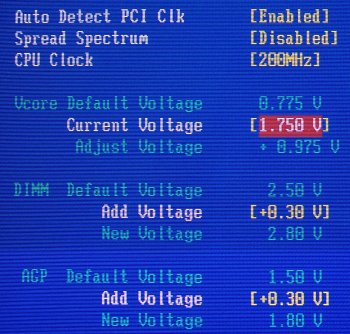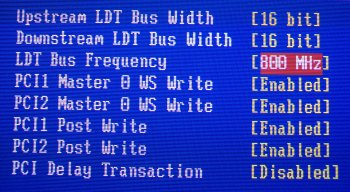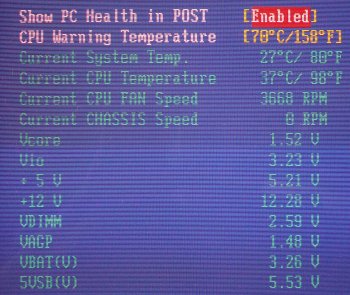EPoX 8HDA3+ (K8T800) BIOS
Board layout and features are important considerations in a potential buyer's decision-making process. EPoX has made its name by providing motherboards that go beyond the call of duty, especially with respect to the malleable BIOSes that offer significant tweaking abilities.

EPoX's voltage section falls under the PowerBIOS subscreen. AMD Athlon 64 CPUs run at a native 200MHz. You simply multiply this by the multiplier (duh) to get a final speed which, in this case, is 2000MHz. The CPU clock can be tuned from 200MHz - 250MHz. Unlike the present Barton / XP range, there's no multiplier options available. AMD now uses an integrated heatspreader but it now appears that 940-pin Hammer-based CPUs are unlocked - it's just a case of the motherboard supporting the feature. We've yet to discern if this is the case with regular 754-pin Clawhammers as there's no multiplier option on this board, unfortunately. There's no explicit mention of an AGP / PCI locking mechanism. We'll come to that a little later. Voltage-wise, there's a small mistake with the default voltage setting. It's reckoned to be 0.775v - if only that were true. The test Athlon 64 3200+ ran at a default 1.5v. Voltage could be manipulated from 1.35v - 1.75v in rather large jumps. 2.8v VDIMM and 1.8v VAGP is pretty standard on an enthusiast board.

The above shot shows all the DRAM tweaking options available on the 8HDA3+. An e-mail was sent to EPoX U.K requesting DRAM timings adjustments. EPoX's answer was that the initial boards will focus on stability before pure performance. That's why DRAM timings are effectively locked out. We may see a BIOS update that'll give us the usual 2-6-2-2 timings, but we wouldn't put our house on it. The initial FX-51 review highlighted just how the memory speeds are governed and implemented by the DRAM controller. Put simply, the memory controller runs at core speed so a divisor is necessary to run today's memory at its rated specification. EPoX offers the user a maximum memory clock ( a divisor that doesn't go past the stated DRAM speeds if the CPU's left at stock). The K8T800, in this configuration, supports single-channel DDR400 memory out of the box. That infers a memory divisor of 10 here (2000/10 = 200MHHz = DDR400). We suppose that the different maximum memory clocks work in the same method that Intel's CPU-to-RAM ratios currently define speeds on Canterwood / Springdale boards. The methods are quite different, but they conspire to achieve the same goal.

Lightning Data Transport was the name first given to AMD's HyperTransport bus link between CPU and chipset. VIA makes noises about it running the link at full speed, that's 800MHz, double-pumped, with a 16-bit wide bus in each direction. 6.4GB/s all told. There's little need for it now, but it's pleasing to see it run to AMD's specifications.

Notice how cool the CPU is with quiet air cooling ?.









